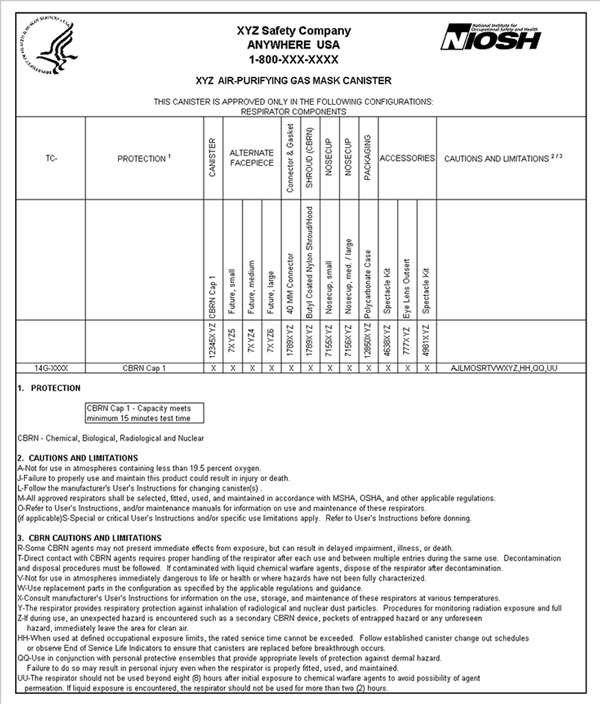NPPTL Sample Air-Purifying Gas Mask Canister Approval Label

APR Approval Form
XYZ Air-Purifying Gas Mask Canister
The canister is approved only in the following configurations:Respirator Components
The columns listed in the table are TC, Protection, Canister, Alternate FacePiece, Connection and Gasket, Shroud CBRN, Nosecup, nosecup, packaging, accessories, cautions and limitations 2/3 and they show the part number and description.
1. Protection
CBRN Cap1 – Capacity meets minimum 15 minutes test time
CBRN Chemical, Biological, Radiological and Nuclear.
2. Cautions and Limitations
A – Not for use in atmospheres containing less than 19.5 percent oxygen.
J – Failure to properly use and maintain this product could result in injury or death.
L – Follow the manufacturers Users Instructions for changing canisters.
M – All approved respirators shall be selected, fitted, used, and maintained in accordance with MSHA, OSHA, and other applicable regulations.
O – Refer to Users Instructions, and/or maintenance manuals for information on use and maintenance of these respirators. (if applicable)
S – Special or critical Users Instructions and/or specific use limitations apply. Refer to Users Instructions before donning.
3. CBRN Cautions and limitations
R – Some CBRN agents may not present immediate effects from exposure, but can result in delayed impairment, illness, or death.
T – Direct contact with CBRN agents requires proper handling of the respirator after each use and between multiple entries during the same use. Decontamination and disposal procedures must be followed. If contaminated with liquid chemical warfare agents, dispose of the respirator after decontamination.
V – Not for use in atmospheres immediately dangerous to life and health or where hazards have not been fully characterized.
W – Use replacement parts in the configuration as specified by the applicable regulations and guidance.
X – Consult manufacturers Users Instructions for information on use.
Y – The respirator provides respiratory protection against inhalation of radiological and nuclear particles. Procedures for monitoring radiation exposure and full.
Z – If during use, an unexpected hazard is encountered such as a secondary CBRN, pockets of entrapped hazard or any unforseen hazard, immediately leave the area for clean air.
HH – When used at defined occupational exposure limits, the rated service time cannot be exceeded. Follow established canister change out schedules or observe End of Service Life Indicators to ensure that canisters are replaced before breakthrough occurs.
QQ – Use in conjunction with personal protective ensembles that provide appropiate levels of protection against dermal hazard. Failure to do so may result in personal injury even when the respirator is properly fitted, used, and maintained.
UU – The respirator should not be used beyond eight hours after initial exposure to chemical warfare agents to avoid possibly of agent permeation. If liquid exposure is encountered, the respirator should not be used for more than two hours.
